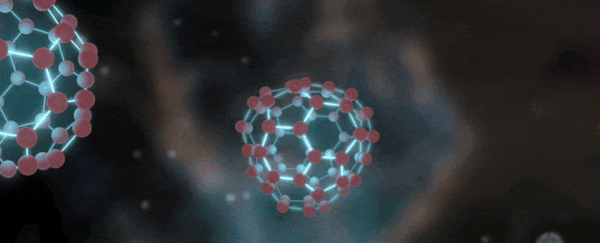Scientists may have just tracked down the source of some mysterious infrared glows detected emanating from stars and clouds of interstellar dust and gas.
These Unidentified Infrared Emission (UIE) bands have baffled scientists for decades; according to a theoretical new work, at least some of these bands can be produced by highly ionized buckminsterfullerene, more commonly known as buckyballs.
"I am extremely honored to have played a part in the astonishingly complex quantum chemistry investigations undertaken by Dr Sadjadi that have led to these very exciting results," said astrophysicist Quentin Parker of Hong Kong University's Laboratory for Space Research.
"They concern first the theoretical proof that Fullerene – Carbon 60 – can survive to very high levels of ionization, and now this work shows the infrared emission signatures from such species are an excellent match for some of the most prominent Unidentified Infrared Emission features known. This should help re-invigorate this area of research."
Buckminsterfullerene (C60) is a molecule consisting of 60 carbon atoms arranged in the shape of a soccer ball or football. Here on Earth, it can be found naturally in soot, the carbon residue left behind by the burning of organic matter.
In space, the molecule was only positively detected recently: in 2010, it was detected in a nebula, in 2012, it was found in the gas around a star, and in 2019, it was found in the tenuous gas that drifts in the 'empty' space between the stars.
It's not clear exactly how the buckyballs get there, although recent research suggests that they (like quite a few other things) are forged by dying stars. Since they are there, though, scientists have been fascinated to probe its properties, and what can happen to it in the big wide Universe.
Previously, Parker and his colleague, astrophysicist SeyedAbdolreza Sadjadi, also of the Laboratory for Space Research, showed that buckyballs can take quite a beating from the harsh conditions of space.
In particular, they can become highly ionized – the process of adding or removing electrons. Up to 26 electrons can be subtracted from a buckyball before it collapses.
What that research didn't cover was the changes that level of ionization would wreak on the light emitted by the buckyballs. Sadjadi, Parker and their colleagues Chih-Hao Hsia and Yong Zhang, both also affiliated with the Laboratory for Space Research, set out to investigate.
They conducted a series of quantum chemical calculations to determine the wavelengths in which these molecules might be seen.
Then, they compared their findings to infrared observations of six objects, including stars and nebulae. The results, said the researchers, are both interesting and provocative.
The team found that ionized buckyballs are likely to emit mid-infrared light at some of the key wavelengths associated with UIE – at 11.21, 16.40, and 20-21 micrometers.
Even more pertinently, the emission of buckyballs with 1 to 6 electrons removed can be very easily distinguished from the infrared emission of another type of carbon molecule, polycyclic aromatic hydrocarbons, or PAHs, which are associated with the 6.2-micrometer band.
Since PAHs are another candidate carrier of UIE, this means that not only are buckyballs a strong candidate, but they can be easily distinguished from other potential carriers.
The team believes that this research presents a strong case for future observations in the mid-infrared wavelength range to help track down and identify the UIE associated with ionized buckminsterfullerene.
"In our first paper we showed theoretically that highly ionized fullerenes can exist and survive the harsh and chaotic environment of space. It is like asking how much air you can push out of a football ball and the ball still maintains its shape," Sadjadi said.
"In this paper we worked with two other leading astrophysicists and planetary scientists … to determine the molecular vibrational notes of a celestial symphony, i.e., the spectral features that these ionized buckyballs would play/produce. We then hunted for them in space showing their notes/signatures are easily distinguishable from PAHs."
The research has been published in The Astrophysical Journal.
